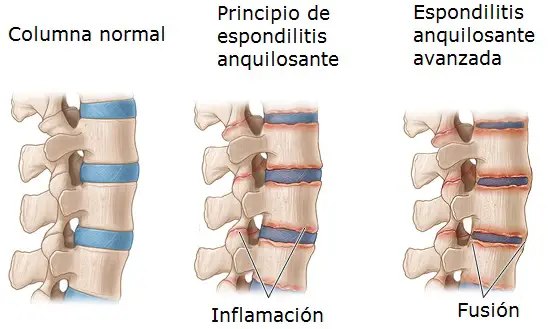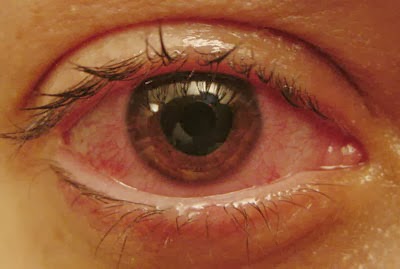¿Whaté is it ankylosing spondylitis? Ankylosing spondylitis is a painful and progressive type of arthritis, where some or all of the joints and the bones of the spine rub together.
This disease cannot be cured and the sísymptoms can range from Back pain and stiffness, long-term disability.
It is estimated that only in Europe ankylosing spondylitis affects the 0,3 al 1,8 % of the populationón.

Index
Causes of ankylosing spondylitis
The cause of ankylosing spondylitis is unknown., although researchers have shown that people with this disorder are más likely to have a certain gene markerénamed HLA -B27.
If there is a family history of ankylosing spondylitis in parents or siblings and the person alsoén is positive for the HLA marker- B27, there is a probability of 20% for that individual from developing ankylosing spondylitis if éhe or she is under 40 añyou of age.
The odds are much más casualties in older than 40 años. Además, some researchers areán exploring a partnershipón between certain bacteria and ankylosing spondylitis.
Sísymptoms of ankylosing spondylitis

It is important to note that not everyone develops the following síntomas, but these are possibilities depending on the severity of the condition.ón:
- Stiffness and pain in the lower back, glútits and hips when waking up in the morningñana the después of a foríidle ear.
- Back pain is relieved with movement and exercise.
- Difficulty flexing the spine.
- Pain in the hips and difficulty walking.
- Pain in the heels and soles of the feet.
- stooped posture.
- Fever.
- Péloss of appetite, péweight loss.
- Fatigue, decreaseóno of energyía.
- swellingóno of the eyes, redness and pain.
- Sensitivity to light.
- Difficulty breathing deeply (porque la expandedión of the tórax is diffíeasy and painful).
- heart failureíaca.
Consult a méI say yes:
- You develop persistent lower back pain.
- You notice that you feel pain and stiffness in your back in the morning.ñana but improves with movement and exercise.
- Do you have any difficulty or pain when taking a breath?ón deep.
- You have redness or swellingónot in the eye, o if isás abnormally sensitive to light.
- You develop an unexplained fever, péloss of appetite, péweight loss or tiredness.
Diagnosis of ankylosing spondylitis
There is no definitive test for the diagnosis.óankylosing spondylitis. The biggestíto of the médoctors wait to see x-ray evidence of inflammationón of the jointón between the sacrum (the triangular bone in the part más lower back) and the ilium (the boneás big on top of hip), así as any of the following signs:
- Inflammatory pain in the back (gradual start, how long máit's three months, with stiffness and pain that is worse in the handñhe, but it gets better with movement).
- Reduced mobility of the spine.
- decreaseón the ability to expand the chest.
youédico can prescribe a big núnumber of blood tests that may suggest ankylosing spondylitis.
For instance, if you suffer from ankylosing spondylitis, you probably have a higher sedimentation rateón globular (the rate at which glóred bulls settle out of blood) and increased protein levelsíby C- reactive (a proteiníana that is not normally found in the blood but can appear in cases of inflammationón). [source]
These two tests are general indications of inflammation.ónot in your body. Although you may have anemia and your blood probably won't show rheumatoid factor (an antibody withún in cases of rheumatoid arthritis) or anti antibodies- nuclear (common in lupus and other similar conditions).
About the 95 % of people with ankylosing spondylitis are positive for the HLA-B27 marker.

Treatments for ankylosing spondylitis
If you are diagnosed with ankylosing spondylitis, to beá It is very important that you seek the help of a physical therapist.
The regular exercise and efforts to maintain mobility can make the difference between preservingóNo of your movement and independence, or stay weakened.
The breathing exercisesón can help to maintain the tor boxácica flexible. the swimmingóThey are an excellent form of exercise for people with spondylitis because they help maintain the extensionóproper n of the spine.
For smokers, it is advisable to quit tobacco, due to possible breathing problems associated with ankylosing spondylitis that can shorten your life expectancy.
Good posture is important. Patients must choose chairs, tables and other work surfaces that help prevent awkward posturesíhunched over. Avoid lifting your legs, since it can lead to fusióNo hip or knee positionón bent.
Patients are encouraged to sleep on a mattressón hard with your back straight. Spaghettién are advised not to sleep on multiple pillows with their necks flexed forward.
Avoid sudden impacts, like the jumps or the caíthe, there are more chances of injuryóIt would be that in a person without this conditionón.
During outbreaks of the disease, you may need to take anti-aging medications.- inflammatory. If the degree of the disease is severe, may require occasional injections of steroids directly into the joints más inflamed.
The drugs sulfasalazine and methotrexate help some people with ankylosing spondylitis.. The medicines más new are the so-called TNF blockers – etanercept, adalimumab y golimumab. Spaghettién may be recommended for some people with ankylosing spondylitis.
If with this conditionón you develop severe arthritis of the hip, you may need surgeryíto replace your hip. If you develop inflammationóno of the eye, I will give youán steroid eye drops.
Cóhow to prevent ankylosing spondylitis
There are no known ways to prevent ankylosing spondylitis.. Conditionón is due in part to the geneética, although you may not be aware of someone in your family having similar problems.